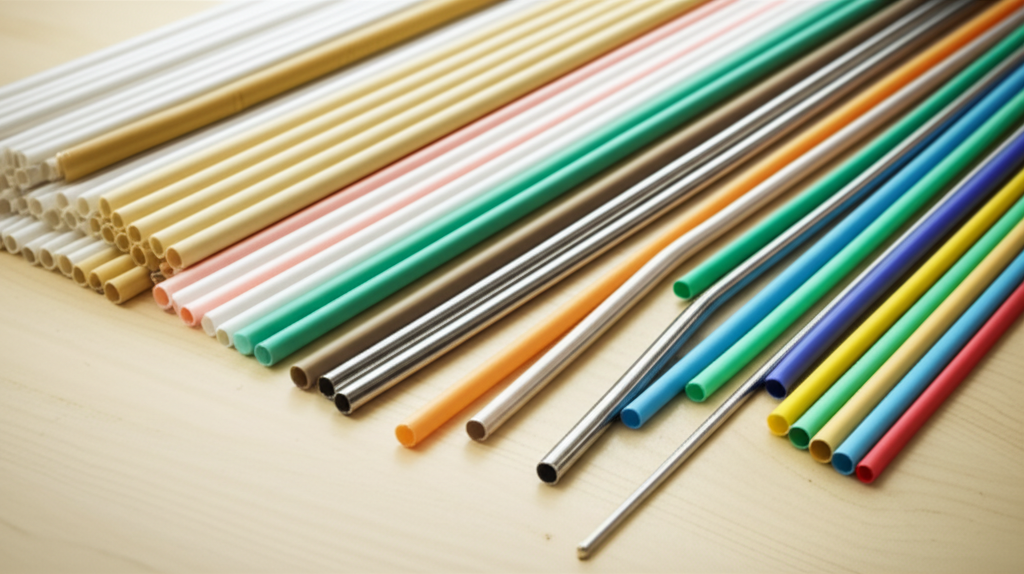
The Unavoidable Shift: Why Businesses Must Embrace Non-Plastic Straws Now
The tide of plastic pollution has risen to a critical level, demanding immediate and decisive action from industries worldwide. For years, single-use plastic straws, once a ubiquitous convenience, have become a potent symbol of this environmental crisis, contributing significantly to ocean waste and microplastic contamination that infiltrates our ecosystems and even our food chains. This escalating global concern is not merely an abstract environmental issue; it is rapidly transforming the operational landscape for modern businesses, bringing with it a torrent of regulatory pressure that is impossible to ignore. Governments and municipalities across the globe, from the European Union’s comprehensive Single-Use Plastics Directive to numerous U.S. state and city-wide bans, are enforcing strict limitations on these disposables, necessitating a fundamental shift in business practices.
The immediate impact on corporate brand image is profound. Consumers, now more environmentally aware than ever, are actively seeking out and rewarding businesses that demonstrate a genuine commitment to sustainability. Failure to adapt not only risks regulatory non-compliance but also a significant blow to brand reputation, alienating a growing segment of eco-conscious customers. In a competitive marketplace, the transition to non-plastic drinking straws is no longer a commendable option but a strategic imperative for long-term viability and market relevance. It’s about demonstrating corporate social responsibility (CSR) and future-proofing your business against evolving consumer expectations and stringent environmental legislation.

Navigating the Sustainable Straw Landscape: Options and Market Trends
The journey beyond traditional plastic has unveiled a rich spectrum of eco-friendly straw alternatives, each with unique characteristics and benefits. From the historical resurgence of paper straws, first patented in the late 19th century by Marvin C. Stone, to innovative modern materials, businesses now have diverse choices. This shift is driven not only by environmental consciousness but also by robust market dynamics. The global eco-friendly straws market is experiencing significant growth, projected to reach nearly USD 25.1 billion by 2035 from USD 12.3 billion in 2025, reflecting a compound annual growth rate (CAGR) of 7.3%. This surge is notably strong in regions like North America and Europe, where environmental awareness and stringent regulations are particularly influential. For example, the widespread adoption of plastic straw bans in many European countries has accelerated the demand for alternatives, while in the U.S., states like California and Washington have led the charge in mandating sustainable options.
Beyond the regulatory push, consumer demand is a powerful catalyst. A growing segment of the population actively seeks out and prefers businesses committed to sustainable practices. Adopting non-plastic straws, therefore, is more than just compliance; it’s an opportunity to enhance your corporate social responsibility initiatives and strengthen your brand’s positive positioning. This strategic move aligns your business with global sustainability efforts, resonating with a demographic that values environmental stewardship. Understanding the nuances of these alternatives is key to making an informed decision that benefits both your bottom line and the planet. For further insights into integrating sustainable practices, explore our resources onmomoio.comon sustainable procurement strategies.

Choosing the Right Sustainable Straw: A Strategic Decision for Operational Excellence
Selecting the appropriate non-plastic straw is a critical strategic decision that demands a thorough evaluation of material attributes, performance, cost implications, and suitability for specific operational models. The right choice enhances the customer experience, optimizes operational efficiency, and reinforces your brand’s commitment to sustainability. Consider the following comparison of popular non-plastic straw materials:
| Tipo de paja | Key Benefits (B2B Focus) | Considerations (B2B Focus) | Ideal Business Use Cases |
|---|---|---|---|
| Pajitas de papel | Biodegradable, Compostable, Highly Customizable, Mass-producible | Can soften quickly, Production resource-intensive, Potential PFAS controversy | High-volume quick-service, Takeout, Event catering |
| Pajitas de bambú | Rapidly renewable, Natural aesthetic, Naturally antibacterial | Shorter lifespan than metal/glass, Requires thorough cleaning for hygiene, Subtle taste | Eco-themed cafes, Outdoor dining, Sustainable brand alignment |
| Metal Straws (SS) | Highly durable, Reusable, Recyclable, Dishwasher-safe | Higher initial environmental impact (use 37+ times to break even with plastic) | Upscale bars, Restaurants, Employee benefits/gifts |
| Pajitas de vidrio | Highly hygienic, Transparent, Elegant aesthetic, No taste transfer | Breakable if dropped, Heavier, Higher initial impact (use 23+ times to break even) | Fine dining, Craft cocktail bars, Cafes focused on aesthetics |
| Pajitas de silicona | Flexible, Durable, Reusable, Dishwasher-safe, Kid-friendly | Not biodegradable (recyclable via special programs), Can attract dust, Flexible cleaning | Family restaurants, Casual dining, Healthcare facilities |
| Plant-based/Edible Straws | Zero-waste solution, Biodegradable, Novelty factor | Sogginess (pasta), Specific industrial composting requirements (PLA), Niche applications | Innovative brands, Specialty cafes, Zero-waste initiatives, Events |
Beyond simply complying with regulations, investing in non-plastic straws can yield significant competitive advantages and tangible long-term cost savings. While the initial procurement cost for some alternatives may be higher than traditional plastic, the reusability of options like metal, glass, and silicone can lead to substantial reductions in ongoing purchasing and waste disposal expenses over time. For example, a quality metal straw, used over 37 times, can become more environmentally friendly than a single-use plastic one, demonstrating a favorable return on investment.
This strategic move strengthens brand loyalty, attracting the growing segment of environmentally conscious consumers and positioning your business as a sustainability leader. Progressive operational strategies, such as implementing “straw upon request” policies, like those adopted by major chains such as Starbucks with their strawless lids, further reduce waste and enhance customer satisfaction by offering choice and demonstrating proactive environmental stewardship. Explore how innovative eco-friendly solutions can transform your operations atmomoio.com. These strategic choices not only reduce your environmental footprint but also unlock new market opportunities and solidify your reputation as a forward-thinking enterprise.

Your Next Step Towards a Greener Future: Partnering for Sustainable Solutions
The imperative for businesses to transition definitively to sustainable straw solutions is clear. The escalating global plastic crisis, coupled with intensifying regulatory pressure and evolving consumer expectations, makes this shift not just an ethical choice but a commercial necessity. The vast array of non-plastic options available today means that there is a sustainable straw tailored to every business model and brand aesthetic, from high-volume quick-service operations to upscale fine dining establishments. The critical importance lies in selecting the right type, considering factors like material performance, cost-effectiveness, and alignment with your specific operational needs and brand values.
The market is poised for significant growth in eco-friendly alternatives, as detailed in reports by organizations like the World Economic Forum, highlighting the widespread commitment to a circular economy. Businesses that act now will not only meet compliance requirements but also gain a competitive edge by demonstrating leadership in environmental responsibility. The journey towards a greener future for your business starts with informed decisions and strategic partnerships. For further information on the environmental impact of plastic pollution, consider resources from theEnvironmental Protection Agency.
Ready to elevate your business’s sustainability profile and meet evolving consumer demands?
Visitmomoio.comto learn more about our commitment to empowering businesses with green solutions. Embrace the future of sustainable business and become a leader in the global shift away from single-use plastics.






